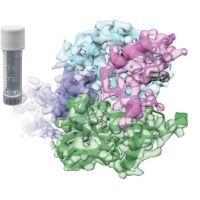Specification
| Organism | Homo sapiens (Human) |
| Expression Host | E.coli |
| Tag Info | N-terminal GST-tagged |
| Purity | Greater than 85% by SDS-PAGE |
| Uniprot ID | P62877 |
| Gene Names | RBX1 |
| Alternative Names | Protein ZYP RING finger protein 75 RING-box protein 1 |
| Expression Region | Full Length(1-108aa ) |
| Molecular Weight | 39.3 kDa |
| Protein Sequence | MAAAMDVDTPSGTNSGAGKKRFEVKKWNAVALWAWDIVVDNCAICRNHIMDLCIECQANQASATSEECTVAWGVCNHAFHFHCISRWLKTRQVCPLDNREWEFQKYGH |
| Form | Liquid or Lyophilization |
| Buffer | The default storage buffer is Tris/PBS-based buffer, 5%-50% glycerol if the delivery form is liquid. The lyophilization buffer is Tris/PBS-based buffer, 6% Trehalose, pH 8.0 if the delivery form is lyophilized powder. Please contact us if you have any special requirment. |
| Reconstitution | Please reconstitute protein in deionized sterile water and we recommend that briefly centrifuge thevial prior to opening the vial .We recommend aliquot for long-term storage at -20℃/-80℃. |
Background
| Relevance | E3 ubiquitin ligase component of multiple cullin-RING-based E3 ubiquitin-protein ligase (CRLs) complexes which mediate the ubiquitination and subsequent proteasomal degradation of target proteins, including proteins involved in cell cycle progression, signal transduction, transcription and transcription-coupled nucleotide excision repair. CRLs complexes and ARIH1 collaborate in tandem to mediate ubiquitination of target proteins, ARIH1 mediating addition of the first ubiquitin on CRLs targets. The functional specificity of the E3 ubiquitin-protein ligase complexes depends on the variable substrate recognition components. As a component of the CSA complex promotes the ubiquitination of ERCC6 resulting in proteasomal degradation. Through the RING-type zinc finger, seems to recruit the E2 ubiquitination enzyme, like CDC34, to the complex and brings it into close proximity to the substrate. Probably also stimulates CDC34 autoubiquitination. May be required for histone H3 and histone H4 ubiquitination in response to ultraviolet and for subsequent DNA repair. Promotes the neddylation of CUL1, CUL2, CUL4 and CUL4 via its interaction with UBE2M. Involved in the ubiquitination of KEAP1, ENC1 and KLHL41. In concert with ATF2 and CUL3, promotes degradation of KAT5 thereby attenuating its ability to acetylate and activate ATM. |
| Involvement in Disease | |
| Subcellular Location | Cytoplasm, Nucleus |
| Protein Families | RING-box family |
| Tissue Specificity | RBX1 |
QC Data
| Note | Please contact us for QC Data |
| Product Image (Reference Only) |  |

